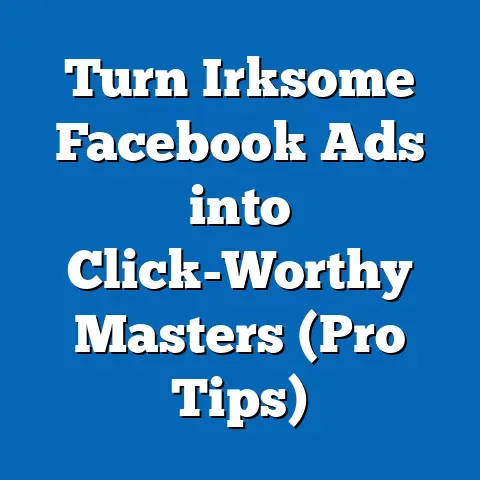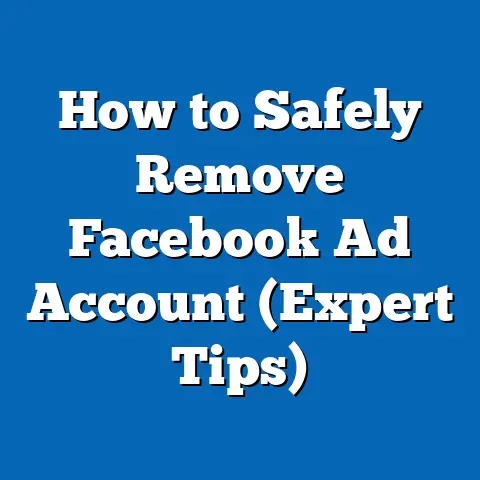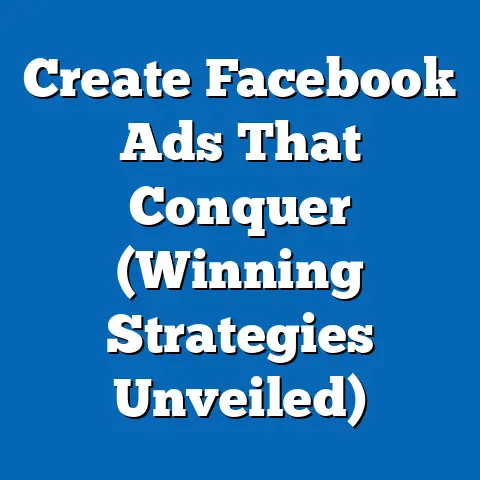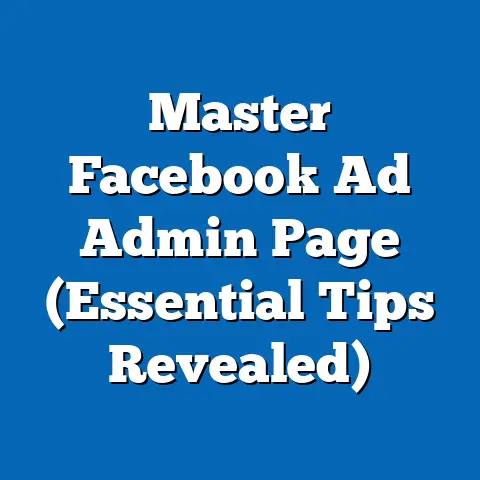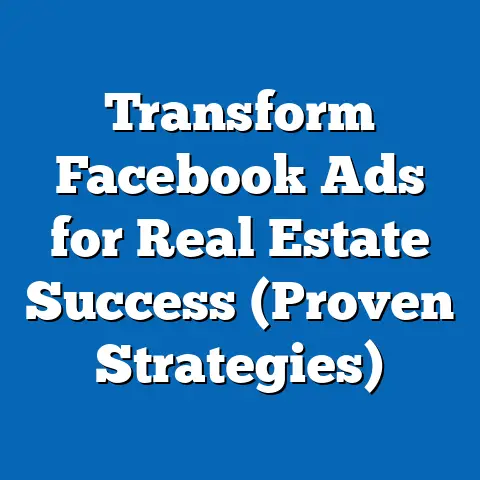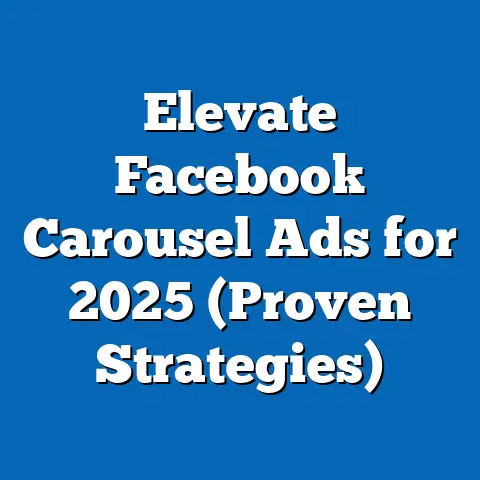Boost Campaigns with Winning Facebook Ad Examples (Pro Tips)
Do you remember the first time you scrolled through Facebook and an ad actually stopped you in your tracks? An ad that spoke directly to your needs, desires, or maybe even made you laugh out loud? I do. It was for a local coffee shop offering a free pastry with any coffee purchase. Simple, but effective. That’s the power of a well-crafted Facebook ad.
In today’s digital marketing landscape, Facebook advertising is not just an option; it’s a necessity for businesses looking to connect with their target audience, drive traffic, and boost conversions. With billions of active users, Facebook offers unparalleled reach and targeting capabilities. But simply throwing money at ads won’t cut it. To truly succeed, you need to understand the anatomy of a winning ad, learn from successful campaigns, and avoid common pitfalls.
That’s exactly what I’m going to help you with in this guide. I’ll delve into the world of Facebook ads, sharing pro tips and real-world examples to help you craft campaigns that not only grab attention but also deliver tangible results. Let’s get started!
Understanding Facebook Ads
Before diving into the specifics of creating winning ads, it’s essential to grasp the fundamentals of Facebook advertising. This includes understanding what Facebook ads are, why they’re important, and how they fit into the broader digital marketing ecosystem.
What Are Facebook Ads?
Facebook ads are paid messages that businesses use to reach potential customers on the Facebook platform. Unlike organic posts, which are only seen by users who already follow your page, ads can be targeted to specific demographics, interests, and behaviors. This allows you to reach a much wider audience and connect with people who are most likely to be interested in your products or services.
Evolution of Facebook Ads:
I remember when Facebook ads were simple text-based messages with minimal targeting options. Over the years, the platform has evolved dramatically, offering a wide range of ad formats, advanced targeting capabilities, and sophisticated analytics tools. Today, you can create visually stunning ads with interactive elements, target users based on their online activity, and track the performance of your campaigns in real-time.
Significance in Digital Marketing:
In today’s crowded digital landscape, Facebook ads are a crucial component of any successful marketing strategy. They offer a cost-effective way to reach a large audience, drive traffic to your website, and generate leads and sales. According to Statista, Facebook’s advertising revenue reached nearly $117 billion in 2022, highlighting the platform’s dominance in the digital advertising space.
Defining Your Target Audience
One of the most powerful features of Facebook advertising is its ability to target specific audiences. This means you can show your ads to people who are most likely to be interested in your products or services, based on their demographics, interests, and behaviors.
Why is Targeting Important?
I’ve seen firsthand how effective targeting can be. In one campaign I ran for a local bookstore, we targeted users who had expressed an interest in reading, literature, and specific authors. The result was a significant increase in website traffic and online book sales.
Facebook’s Targeting Capabilities:
Facebook offers a wide range of targeting options, including:
- Demographics: Target users based on age, gender, location, education, and more.
- Interests: Target users based on their interests, hobbies, and activities.
- Behaviors: Target users based on their online behavior, such as purchase history and website visits.
- Custom Audiences: Create custom audiences based on your existing customer data, such as email lists and website visitors.
- Lookalike Audiences: Create lookalike audiences based on your custom audiences, allowing you to reach new users who share similar characteristics with your existing customers.
Creating Effective Audience Personas:
To make the most of Facebook’s targeting capabilities, it’s essential to create detailed audience personas. This involves researching your target audience and developing fictional representations of your ideal customers. For each persona, consider factors such as:
- Demographics: Age, gender, location, income, education, occupation
- Interests: Hobbies, activities, favorite brands, influencers they follow
- Pain Points: Challenges and frustrations they face
- Goals: What they hope to achieve
- Online Behavior: Websites they visit, social media platforms they use
By creating detailed audience personas, you can ensure that your ads are highly relevant to your target audience, increasing the likelihood of engagement and conversions.
Defining Your Campaign Objectives
Before launching any Facebook ad campaign, it’s crucial to define your objectives. What do you hope to achieve with your ads? Are you looking to increase brand awareness, drive traffic to your website, generate leads, or boost sales?
Different Campaign Objectives:
Facebook offers a range of campaign objectives to choose from, including:
- Awareness: Increase brand awareness and reach a wider audience.
- Traffic: Drive traffic to your website or landing page.
- Engagement: Increase engagement with your posts and page.
- Leads: Generate leads for your business.
- App Promotion: Promote your mobile app.
- Sales: Boost online sales and conversions.
Aligning Objectives with Ad Strategy:
The campaign objective you choose will inform your ad strategy, including your targeting, ad creative, and call-to-action. For example, if your objective is to increase brand awareness, you might focus on creating visually appealing ads that showcase your brand’s personality and values. If your objective is to drive traffic to your website, you might use ads with compelling headlines and descriptions that encourage users to click through.
Setting Realistic Goals:
It’s important to set realistic goals for your Facebook ad campaigns. Don’t expect to see overnight results. Instead, focus on tracking your performance over time and making adjustments as needed.
Takeaway: Understanding the fundamentals of Facebook advertising, including defining your target audience and setting clear campaign objectives, is essential for success. By taking the time to plan your campaigns carefully, you can increase the likelihood of achieving your desired results.
Anatomy of a Winning Facebook Ad
Now that we’ve covered the basics of Facebook advertising, let’s dive into the specific elements that make a winning ad. This includes analyzing the importance of visual elements, crafting compelling ad copy, and using a strong call-to-action.
Visual Elements: Capturing Attention
In the fast-paced world of social media, you have just a few seconds to capture a user’s attention. That’s why visual elements are so crucial to the success of your Facebook ads. Eye-catching images, videos, and graphics can help your ads stand out from the crowd and grab users’ attention.
Importance of High-Quality Visuals:
I’ve learned that investing in high-quality visuals is one of the best things you can do for your Facebook ad campaigns. Blurry images, poorly lit videos, and amateurish graphics can turn users off and damage your brand’s reputation.
Types of Visuals:
Facebook offers a variety of visual ad formats, including:
- Images: Use high-quality images that are relevant to your target audience and your brand.
- Videos: Create engaging videos that tell a story and capture users’ attention.
- Carousels: Use carousel ads to showcase multiple products or services.
- Slideshows: Create slideshows from a series of images or videos.
- Instant Experiences: Create immersive, full-screen experiences that load instantly on mobile devices.
Best Practices for Visuals:
- Use high-resolution images and videos: Ensure that your visuals are clear and sharp.
- Choose visuals that are relevant to your target audience: Select images and videos that resonate with your target audience’s interests and values.
- Use bright colors and eye-catching designs: Make your visuals stand out from the crowd.
- Keep it simple: Avoid cluttering your visuals with too much text or too many elements.
- Test different visuals: Experiment with different images and videos to see what works best.
Ad Copywriting: Crafting Compelling Messages
While visual elements are essential for capturing attention, ad copywriting is what ultimately convinces users to take action. Compelling ad copy can help you communicate your message effectively, build trust with your audience, and drive conversions.
Significance of Effective Headlines and Descriptions:
I’ve found that the headline and description are the most important elements of your ad copy. The headline should grab users’ attention and clearly communicate the value proposition of your product or service. The description should provide more detail and encourage users to take action.
Key Elements of Compelling Ad Copy:
- Clarity: Your ad copy should be clear and easy to understand.
- Relevance: Your ad copy should be relevant to your target audience and their needs.
- Value Proposition: Your ad copy should clearly communicate the value of your product or service.
- Urgency: Your ad copy should create a sense of urgency and encourage users to take action now.
- Call-to-Action: Your ad copy should include a clear call-to-action that tells users what you want them to do.
Writing for Different Audiences:
It’s important to tailor your ad copy to your target audience. What language do they use? What are their pain points and goals? By understanding your audience, you can craft ad copy that resonates with them and increases the likelihood of conversions.
Call-to-Action (CTA): Driving Conversions
The call-to-action (CTA) is the final piece of the puzzle. It’s the instruction that tells users what you want them to do next. A strong CTA can be the difference between a successful ad and a missed opportunity.
Role of a Strong CTA:
I’ve seen firsthand how a well-placed CTA can significantly boost conversions. It provides users with a clear direction and encourages them to take the desired action, whether it’s visiting your website, signing up for a newsletter, or making a purchase.
Types of CTAs:
Facebook offers a variety of CTA buttons to choose from, including:
- Learn More: Direct users to your website or landing page.
- Shop Now: Encourage users to make a purchase.
- Sign Up: Encourage users to sign up for a newsletter or create an account.
- Download: Encourage users to download your app or content.
- Contact Us: Encourage users to contact your business.
Best Practices for CTAs:
- Use a clear and concise CTA: Tell users exactly what you want them to do.
- Make your CTA stand out: Use a contrasting color and a bold font to make your CTA button more visible.
- Create a sense of urgency: Use words like “now” or “today” to encourage users to take action immediately.
- Test different CTAs: Experiment with different CTAs to see what works best.
Takeaway: The anatomy of a winning Facebook ad includes eye-catching visuals, compelling ad copy, and a strong call-to-action. By mastering these elements, you can create ads that grab attention, communicate your message effectively, and drive conversions.
Case Studies of Successful Facebook Ads
To further illustrate the principles of effective Facebook advertising, let’s examine some real-world case studies of successful campaigns. These examples will provide insights into how different businesses have used Facebook ads to achieve their marketing goals.
Case Study 1: Nike’s “Dream Crazy” Campaign
Nike’s “Dream Crazy” campaign, featuring Colin Kaepernick, is a prime example of how a brand can use Facebook ads to generate buzz, spark conversation, and drive sales.
Strategy:
Nike’s strategy was to align its brand with a social cause and appeal to its target audience’s values. The campaign featured a powerful message of perseverance and determination, encouraging viewers to “believe in something, even if it means sacrificing everything.”
Execution:
Nike launched a series of Facebook ads featuring Kaepernick and other athletes who had overcome adversity. The ads were visually stunning and emotionally charged, capturing the attention of viewers and sparking a national conversation.
Results:
The “Dream Crazy” campaign generated significant buzz and media coverage, both positive and negative. While some criticized Nike for taking a political stance, the campaign ultimately resonated with its target audience and drove a significant increase in sales. According to Apex Marketing Group, Nike’s online sales increased by 31% in the days following the campaign launch.
Key Takeaways:
- Align your brand with a social cause: If you choose a cause that resonates with your target audience, you can generate buzz and build brand loyalty.
- Create emotionally charged visuals: Emotionally charged visuals can capture viewers’ attention and make your ads more memorable.
- Don’t be afraid to take a stand: Taking a stand on a controversial issue can be risky, but it can also pay off if it resonates with your target audience.
Case Study 2: Dollar Shave Club’s Viral Video Ad
Dollar Shave Club’s viral video ad is a classic example of how a small business can use humor and creativity to generate buzz and drive sales.
Strategy:
Dollar Shave Club’s strategy was to create a humorous and memorable video that highlighted the value proposition of its razor subscription service. The video was low-budget but highly creative, featuring the company’s founder, Michael Dubin, delivering a witty and irreverent pitch.
Execution:
Dollar Shave Club launched the video on YouTube and promoted it through Facebook ads. The video quickly went viral, generating millions of views and driving a surge in website traffic and subscriptions.
Results:
The video ad was a huge success, helping Dollar Shave Club acquire over 12,000 new subscribers within 48 hours of its launch. The company was later acquired by Unilever for $1 billion.
Key Takeaways:
- Use humor to capture attention: Humor can be a powerful tool for capturing viewers’ attention and making your ads more memorable.
- Highlight your value proposition: Clearly communicate the value of your product or service in your ads.
- Don’t be afraid to be creative: Don’t be afraid to experiment with different ad formats and creative approaches.
Case Study 3: Airbnb’s “Live There” Campaign
Airbnb’s “Live There” campaign is an example of how a brand can use Facebook ads to inspire travel and drive bookings.
Strategy:
Airbnb’s strategy was to showcase the unique experiences that travelers can have when they stay in Airbnb properties. The campaign featured stories of real travelers who had immersed themselves in local cultures and communities.
Execution:
Airbnb launched a series of Facebook ads featuring stunning visuals and compelling stories. The ads were targeted to users who had expressed an interest in travel and specific destinations.
Results:
The “Live There” campaign was a success, helping Airbnb increase brand awareness and drive bookings. The campaign also helped to position Airbnb as more than just a place to stay, but as a way to experience the world in a more authentic and meaningful way.
Key Takeaways:
- Tell a story: Stories can be a powerful tool for connecting with your audience and making your ads more memorable.
- Showcase unique experiences: Highlight the unique experiences that your product or service offers.
- Target users based on their interests and travel preferences: Use Facebook’s targeting capabilities to reach users who are most likely to be interested in your product or service.
Takeaway: These case studies demonstrate the power of Facebook advertising and the importance of having a clear strategy, compelling visuals, and engaging ad copy. By learning from these successful campaigns, you can develop your own winning Facebook ad strategies.
Pro Tips for Crafting Effective Facebook Ads
Now that we’ve explored some successful Facebook ad examples, let’s dive into some pro tips that can help you craft effective campaigns. These tips cover everything from A/B testing to retargeting strategies and leveraging Facebook Insights.
Tip 1: A/B Testing: Optimizing Ad Performance
A/B testing, also known as split testing, is the process of comparing two versions of an ad to see which one performs better. This is a crucial step in optimizing your ad performance and ensuring that you’re getting the most out of your advertising budget.
Importance of A/B Testing:
I’ve found that A/B testing is essential for identifying the most effective ad creative, targeting, and messaging. By testing different variations of your ads, you can learn what resonates with your audience and make data-driven decisions to improve your campaign performance.
What to Test:
- Images: Test different images to see which ones capture the most attention and generate the most clicks.
- Headlines: Test different headlines to see which ones are most compelling and drive the most engagement.
- Descriptions: Test different descriptions to see which ones provide the most information and encourage users to take action.
- CTAs: Test different CTAs to see which ones drive the most conversions.
- Targeting: Test different targeting options to see which ones reach the most relevant audience.
How to Interpret Results:
When A/B testing your ads, it’s important to track key metrics such as:
- Click-Through Rate (CTR): The percentage of users who click on your ad.
- Conversion Rate: The percentage of users who take the desired action after clicking on your ad.
- Cost Per Click (CPC): The amount you pay each time someone clicks on your ad.
- Cost Per Acquisition (CPA): The amount you pay for each conversion.
By analyzing these metrics, you can identify which ad variations are performing best and make adjustments to your campaigns accordingly.
Tip 2: Retargeting Strategies: Reaching Engaged Users
Retargeting is the process of showing ads to users who have already interacted with your business in some way, such as visiting your website, viewing a product page, or adding an item to their cart. This is a highly effective strategy for driving conversions and increasing sales.
Benefits of Retargeting:
I’ve seen firsthand how retargeting can significantly boost conversion rates. By showing ads to users who are already familiar with your brand, you can increase the likelihood that they’ll take the desired action.
Types of Retargeting Ads:
- Website Retargeting: Show ads to users who have visited your website.
- Product Retargeting: Show ads for specific products that users have viewed on your website.
- Cart Abandonment Retargeting: Show ads to users who have added items to their cart but haven’t completed the purchase.
- Email List Retargeting: Show ads to users who are on your email list.
Creating Effective Retargeting Ads:
- Use personalized messaging: Tailor your ad copy to the specific actions that users have taken on your website.
- Offer incentives: Offer discounts or free shipping to encourage users to complete their purchase.
- Use compelling visuals: Use high-quality visuals that showcase your products or services.
Tip 3: Utilizing Facebook Insights: Analyzing Ad Performance
Facebook Insights is a powerful analytics tool that provides valuable data about your ad performance and your audience. By leveraging Facebook Insights, you can gain a deeper understanding of what’s working and what’s not, and make data-driven decisions to improve your campaigns.
How to Access Facebook Insights:
You can access Facebook Insights through the Facebook Ads Manager. Simply select the campaign you want to analyze and click on the “Insights” tab.
Key Metrics to Track:
- Reach: The number of users who have seen your ad.
- Impressions: The number of times your ad has been displayed.
- Frequency: The average number of times each user has seen your ad.
- Click-Through Rate (CTR): The percentage of users who click on your ad.
- Engagement: The number of likes, comments, and shares your ad has received.
- Conversions: The number of users who have taken the desired action after clicking on your ad.
Using Insights to Improve Campaigns:
By analyzing these metrics, you can identify areas where your campaigns are performing well and areas where they need improvement. For example, if you notice that your CTR is low, you might want to test different headlines or images. If you notice that your CPA is high, you might want to adjust your targeting or ad creative.
Tip 4: Keeping Up with Trends: Staying Updated
The world of Facebook advertising is constantly evolving. New features, ad formats, and best practices are introduced regularly. To stay ahead of the curve and ensure that your campaigns are effective, it’s important to keep up with the latest trends.
How to Stay Updated:
- Follow industry blogs and publications: Stay informed about the latest news and trends in Facebook advertising.
- Attend industry conferences and webinars: Learn from experts and network with other marketers.
- Experiment with new features and ad formats: Don’t be afraid to try new things and see what works.
- Join Facebook advertising communities: Connect with other marketers and share your experiences.
Incorporating Trends into Campaigns:
When you identify a new trend, think about how you can incorporate it into your campaigns. For example, if you notice that video ads are performing well, you might want to create a video ad for your business. If you notice that augmented reality ads are becoming popular, you might want to experiment with this new ad format.
Takeaway: These pro tips can help you craft effective Facebook ads that drive results. By A/B testing your ads, retargeting engaged users, leveraging Facebook Insights, and keeping up with trends, you can optimize your campaigns and achieve your marketing goals.
Common Mistakes to Avoid
Even with the best strategies and intentions, it’s easy to make mistakes when creating Facebook ads. Let’s explore some common pitfalls to avoid to ensure your campaigns are successful.
Mistake 1: Poor Audience Targeting
One of the most common mistakes I see is poor audience targeting. This can lead to wasted ad spend and poor campaign performance.
Pitfalls of Poor Targeting:
If you target the wrong audience, your ads will be shown to people who are not interested in your products or services. This can result in low click-through rates, high cost per clicks, and ultimately, a waste of your advertising budget.
How to Avoid Poor Targeting:
- Define your target audience: Clearly identify the demographics, interests, and behaviors of your ideal customers.
- Use Facebook’s targeting options: Take advantage of Facebook’s advanced targeting capabilities to reach the right users.
- Create custom audiences: Use your existing customer data to create custom audiences and target users who are already familiar with your brand.
- Use lookalike audiences: Create lookalike audiences based on your custom audiences to reach new users who share similar characteristics with your existing customers.
Mistake 2: Neglecting Ad Copy and Visual Quality
Another common mistake is neglecting ad copy and visual quality. This can result in ads that are unappealing and ineffective.
Consequences of Poor Ad Copy and Visuals:
If your ad copy is unclear, unengaging, or irrelevant, users are unlikely to click on your ad. Similarly, if your visuals are blurry, poorly lit, or unappealing, users are likely to scroll past your ad without giving it a second thought.
How to Improve Ad Copy and Visuals:
- Write clear and concise ad copy: Use language that is easy to understand and relevant to your target audience.
- Highlight your value proposition: Clearly communicate the value of your product or service in your ad copy.
- Use high-quality visuals: Use images and videos that are clear, sharp, and visually appealing.
- Test different ad copy and visuals: Experiment with different variations to see what works best.
Mistake 3: Ignoring Metrics and Analytics
Ignoring metrics and analytics is a major mistake that can prevent you from optimizing your campaigns and achieving your marketing goals.
Importance of Tracking Metrics:
By tracking key metrics such as reach, impressions, click-through rate, and conversion rate, you can gain a deeper understanding of how your ads are performing and identify areas where they need improvement.
How to Use Metrics to Improve Campaigns:
- Identify underperforming ads: Use metrics to identify ads that are not performing well and make adjustments to improve their performance.
- Optimize targeting: Use metrics to identify the most effective targeting options and refine your audience targeting.
- Adjust ad creative: Use metrics to identify the most effective ad copy and visuals and adjust your ad creative accordingly.
- Track ROI: Use metrics to track the return on investment (ROI) of your campaigns and ensure that you’re getting the most out of your advertising budget.
Takeaway: By avoiding these common mistakes, you can increase the likelihood of creating successful Facebook ad campaigns that drive results. Pay attention to audience targeting, ad copy and visual quality, and metrics and analytics to optimize your campaigns and achieve your marketing goals.
The Future of Facebook Advertising
As technology continues to evolve, so too will Facebook advertising. Let’s take a look at some emerging trends and how advertisers can adapt to changes in Facebook’s algorithms and advertising policies.
Emerging Trends in Facebook Advertising
- AI-Driven Ads: Artificial intelligence (AI) is playing an increasingly important role in Facebook advertising. AI-powered tools can help advertisers automate tasks such as ad creation, targeting, and optimization.
- Augmented Reality (AR) Ads: Augmented reality (AR) ads allow users to interact with products in a virtual environment. This can be a powerful way to showcase products and drive sales.
- Influencer Marketing: Influencer marketing is becoming increasingly popular on Facebook. By partnering with influencers, businesses can reach a wider audience and build trust with potential customers.
Adapting to Changes in Facebook’s Algorithms and Advertising Policies
Facebook’s algorithms and advertising policies are constantly changing. To maintain campaign effectiveness, advertisers need to stay informed about these changes and adapt their strategies accordingly.
How to Adapt:
- Stay informed about Facebook’s updates: Follow Facebook’s official blog and newsroom to stay informed about the latest changes to the platform.
- Experiment with new features and ad formats: Don’t be afraid to try new things and see what works.
- Monitor your campaign performance: Track key metrics to identify any changes in performance and make adjustments as needed.
- Consult with Facebook advertising experts: Seek guidance from experts who can help you navigate the changing landscape of Facebook advertising.
Takeaway: The future of Facebook advertising is likely to be shaped by emerging trends such as AI, AR, and influencer marketing. To maintain campaign effectiveness, advertisers need to stay informed about these trends and adapt their strategies accordingly.
Conclusion
We’ve covered a lot in this guide, from understanding the fundamentals of Facebook advertising to exploring successful case studies and delving into pro tips. I hope this information has been helpful and has inspired you to think creatively and strategically about your own Facebook ad campaigns.
Key Takeaways:
- Facebook advertising is a powerful tool for reaching your target audience and achieving your marketing goals.
- The anatomy of a winning Facebook ad includes eye-catching visuals, compelling ad copy, and a strong call-to-action.
- A/B testing, retargeting strategies, and leveraging Facebook Insights are essential for optimizing your ad performance.
- Avoid common mistakes such as poor audience targeting, neglecting ad copy and visual quality, and ignoring metrics and analytics.
- Stay informed about emerging trends and adapt to changes in Facebook’s algorithms and advertising policies.
Next Steps:
Now it’s time to put what you’ve learned into practice. Start by defining your target audience and setting clear campaign objectives. Then, create compelling ads that capture attention and drive conversions. Don’t be afraid to experiment with different ad formats, targeting options, and messaging. And most importantly, track your performance and make adjustments as needed.
I encourage you to reflect on how you can apply these pro tips and examples to your own Facebook ad campaigns. By taking the time to plan your campaigns carefully, create compelling ads, and optimize your performance, you can boost your marketing efforts and achieve your business goals. Good luck!

